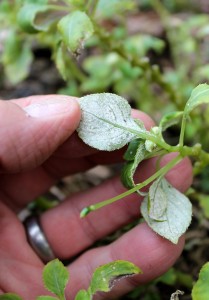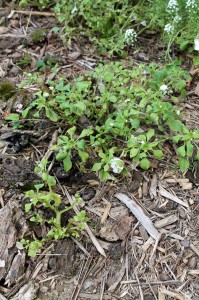Doom for impatiens?
August 21st, 2012
Could this be the end of impatiens as we know them?
You’ve probably grown this popular flower. It’s America’s top-selling annual and our no-brainer, go-to choice for the shade.
But now a virulent new disease strain of downy mildew is threatening to wipe impatiens off the gardening map.
That’s already pretty much been the case in Europe, where some garden centers have stopped selling impatiens because the disease threat is so likely. It’s not known whether downy mildew will take a similar toll here, but some garden centers and growers already are advising gardeners to think twice about planting impatiens next year.
I first heard about the problem two weeks ago when Deb Shearer at Ashcombe’s in Monroe Twp. said she’s been getting a lot of reports about it from gardeners.
Then I did a talk at the Ames True Temper Community Garden, and a lady brought along a bag of dead impatiens to ask if I knew what caused the destruction. She said she had bought five different kinds at five different places, and all of them were melting away.
The problem is caused by a fungi-like water mold that’s deadly to almost all impatiens. There is no cure. The disease spores overwinter and can survive in infected soil for at least a year — maybe several years.
Commercial greenhouses have chemicals that can keep a lid on the problem, but once out in the real world, airborne spores can quickly infect plants.
Even if you try to spray, no fungicides that a homeowner can buy are very effective. Even then, you’d have to spray weekly. And that would get very expensive very quickly.
The disease spreads primarily by airborne spores, although it’s likely that rain and insects also play a role. Since impatiens are so common, that jacks up the risk. So even if your plantings are clean for now, they may not be for much longer. The disease also infects native jewelweed, making that impatiens species another host and disease-spreader.
This is all why growers such as Quality Greenhouses’ Chris Wallen near Dillsburg are telling people that until resistant varieties or better controls come along, the best option might be to just skip impatiens for awhile.
Shearer is telling gardeners the same thing. In the meantime, she’s advising people to pull and trash infected impatiens. She says they need to be landfilled or burned and not simply tossed on the compost pile, where the spores may survive.
The disease starts with stunted growth and a general yellowing of the leaves. Gardeners usually figure it’s a nutrition problem, and so they fertilize, which doesn’t help.
Then the leaves start curling around the edges and dropping. Many a central-Pa. gardener has seen that this summer, but they usually write it off as a result of the intense heat or rotting roots from a recent summer downpour.
The telltale disease sign, though, is the felt-like white coating on the leaf undersides. That growth contains the spores that drop to the ground with the falling leaves to infect the soil.
When that happens, it’s game over.
Trying to keep the foliage as dry as possible might help, but once the disease is around, it’s most likely a matter of time.
That’s too bad because impatiens have long been one of the easiest, most reliable and inexpensive flowers to grow.
If you’re thinking about scrapping impatiens next year, here are some good annual alternatives for shade: coleus, begonias, browallia, torenia, polka-dot plants (Hypoestes), sweet potato vines, caladium and New Guinea impatiens – the one type that’s highly resistant to downy mildew. The branded line of SunPatiens (a blend of bedding impatiens and New Guineas) also are supposedly mildew-resistant.
If your shade is partial, you might also try alyssum, alternanthera, dwarf cleome, dusty miller, mecardonia, flowering tobacco (Nicotiana), nierembergia, petunias, ivy geraniums, verbena and even vinca.









